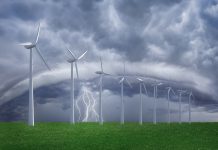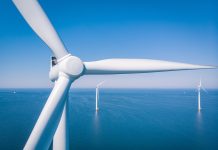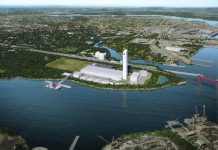Wind turbines are getting bigger and higher. That also means they are getting heavier. In order to get those blades turning, companies that can manage the heavy lifting are a necessity.
That’s where Terex Cranes enters the picture.
Terex began in 1970 as a subsidiary of GM, specializing in producing crawlers, front-end loaders, and scrapers. The company grew through acquisitions and was listed on the New York Stock Exchange in 1995.
In 2003, Terex acquired Demag mobile cranes, which has become a major part of Terex and a key stockholder in wind-turbine construction.
“Demag has been the go-to brand in the wind industry since the introduction of the CC 2800-1,” said Erwann Maillot, global marketing manager for Communication and Brand Development. “This crane was the crane for wind-park erection. Its successor, the Demag CC 3800-1, lives up to its reputation.”
Terex introduced a boom booster kit for the CC 8800-1 in 2014 and for the CC 3800-1 last year.
“They greatly enhance the cranes’ capacities and are efficient to transport,” Maillot said. “But the requirements are constantly evolving, and we are already working on an update to the Demag CC 3800-1 boom booster to meet the increasing weights and heights.”
The cranes required for wind-turbine construction jobs have to out lift the previous generation of cranes, according to Maillot.
“In 2014, we launched the boom booster kit for the CC 8800-1 crawler crane,” he said. “Terex Cranes developed the kit specifically for application scenarios with large loads and long boom systems, which is characteristic of the requirements involved in erecting large wind turbines.”
A boom booster kit offers up to 72 meters of lift-enhancing boom structure, and it can increase the CC 8800-1 crane’s lift capacity by up to 82 percent. It has been designed for quick and cost-effective transportation and can be disassembled and shipped in standard open-top containers.
Terex now offers a boom booster for the CC 8800-1’s smaller sibling, the CC 3800-1. That kit can increase the crane’s lifting capacity by up to 30 percent, and its available in lengths of 24 to 84 meters.
“When equipped with the boom booster kit, the CC 3800-1 can reach an impressive maximum hook height of 174 meters and lift loads of up to 80 (metric) tons,” Maillot said. “These parameters make the CC 3800-1 especially well-suited to erecting large wind turbines, which usually require lifting heights of more than 140 meters.”
Terex and Demag approach customers in general and the wind industry in particular with three goals: customer satisfaction, achieved with strong regional support structures; product quality and reliability, achieved through continuous improvement, designing and buying for quality, and enhanced quality checks at key manufacturing steps; and innovation.
“We will release several new products in the near future including new solutions for the wind industry,” Maillot said.
 Demag is committed to innovation, according to Maillot, and the wind market is a major driver for its cranes.
Demag is committed to innovation, according to Maillot, and the wind market is a major driver for its cranes.
“We have new projects that will help making wind-turbine erection efficient,” he said. “They will help our customers keep up with the ever increasing requirements of the largest wind turbines.”
Many of Terex’s innovations are based on customer feedback, allowing them to operate their Terex and Demag cranes more efficiently.
“Our solutions allow our customers building wind farms to do so in a short time,” Maillot said.
Terex is in direct contact with wind-turbine manufacturers and customers to understand their needs and to be in a position to engineer a crane for their requirements.
“In the near future, we will also launch the Demag TC 3800,” Maillot said. “It will be the successor of the TC 2800, the lattice-boom structure of the CC 3800-1 on an all-terrain chassis. This product category is very specialized, and it is sometimes the only solution on difficult-to-access jobsites.”
Terex is particularly working closely with customers to document challenging jobsites, he said.
“Lately, we collaborated with one of our customers based in Germany for a wind-park job in very specific conditions,” Maillot said. “The space was extremely tight, and the boom had to be assembled along a negative slope.”
The company’s engineers prepared the support structures, and with a crane equipped with a boom booster, split tray, and flex frame, erection of the boom went perfectly, he said.
Terex and Demag are always looking for ways to improve their products for their customers, and Demag has many products and solutions for the wind industry, according to Maillot.
“We are in contact with our customers to provide them with the best solutions, as Demag has the right crane for every wind turbine,” he said.



























